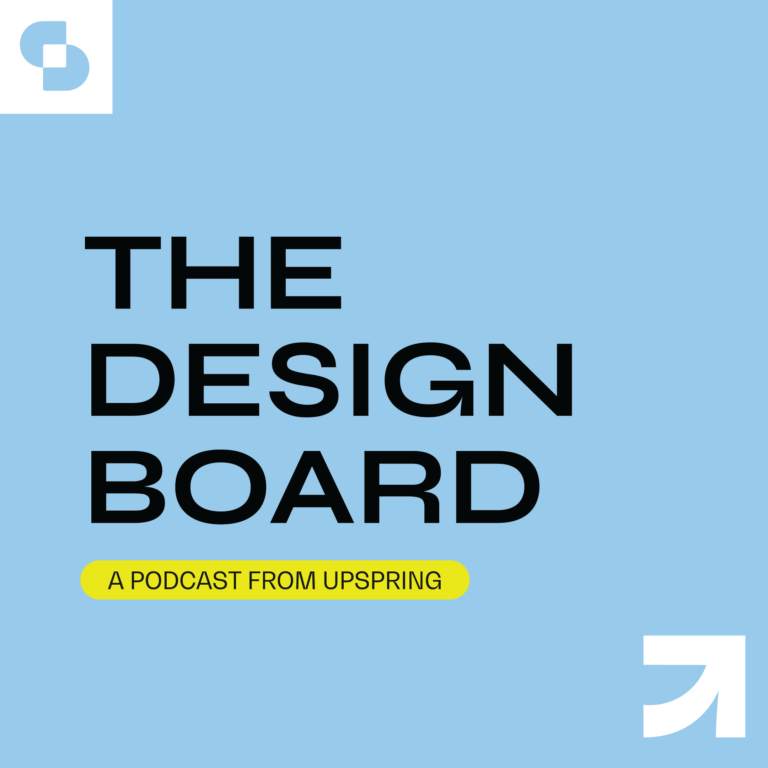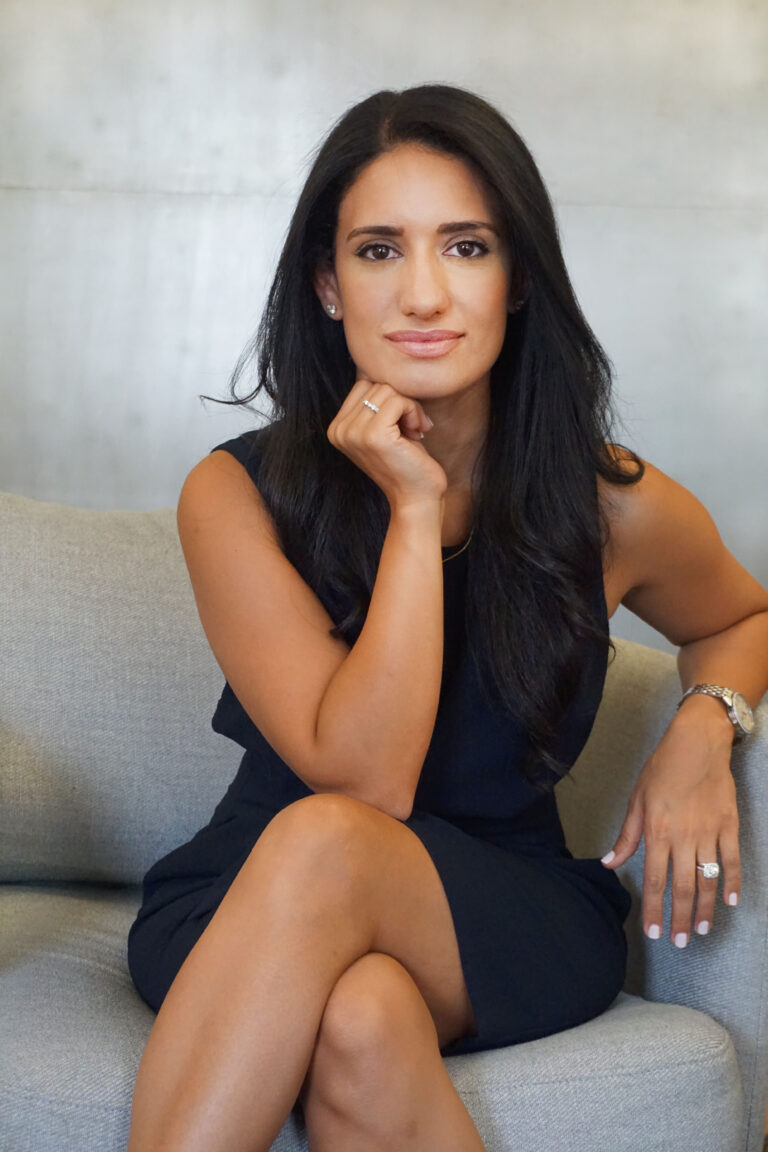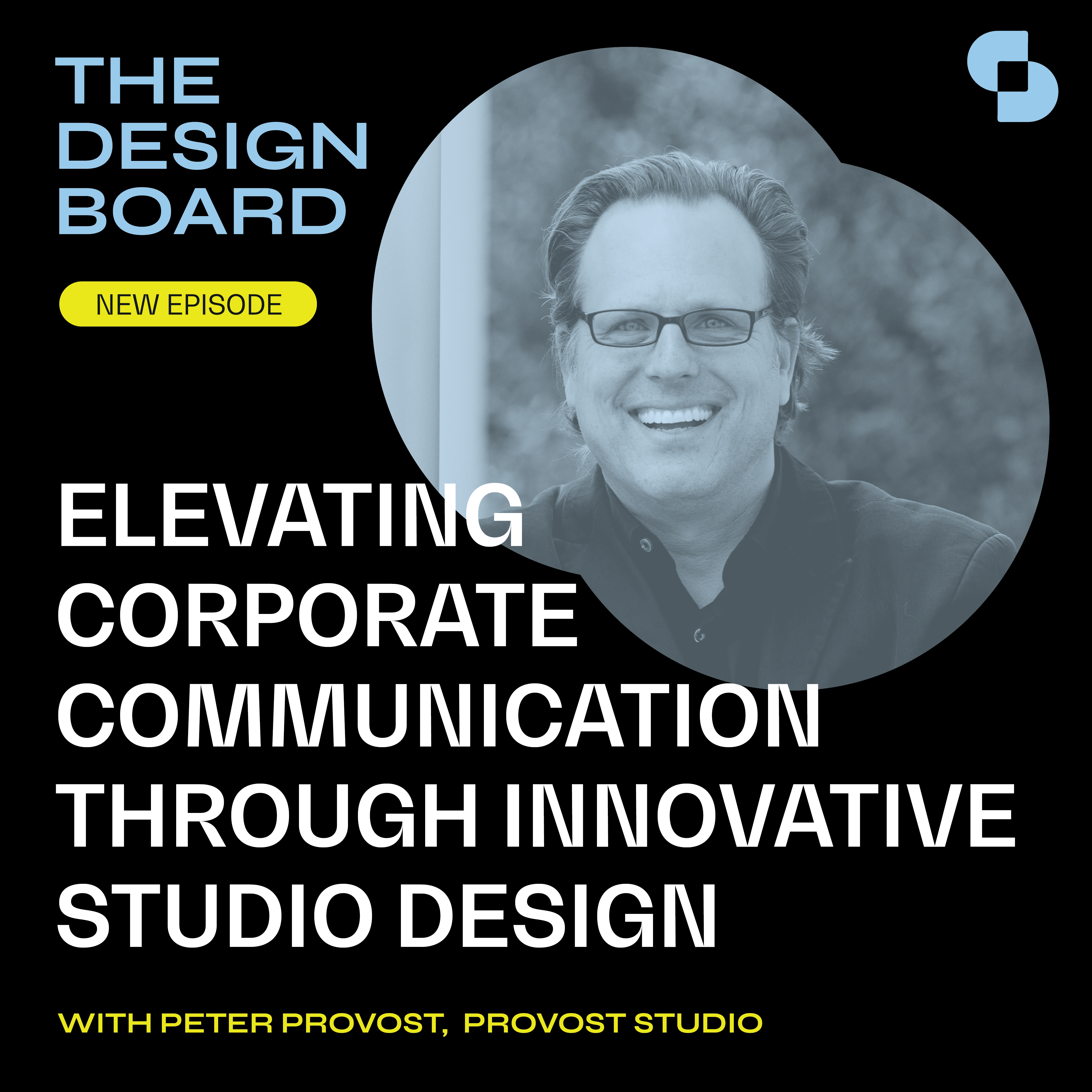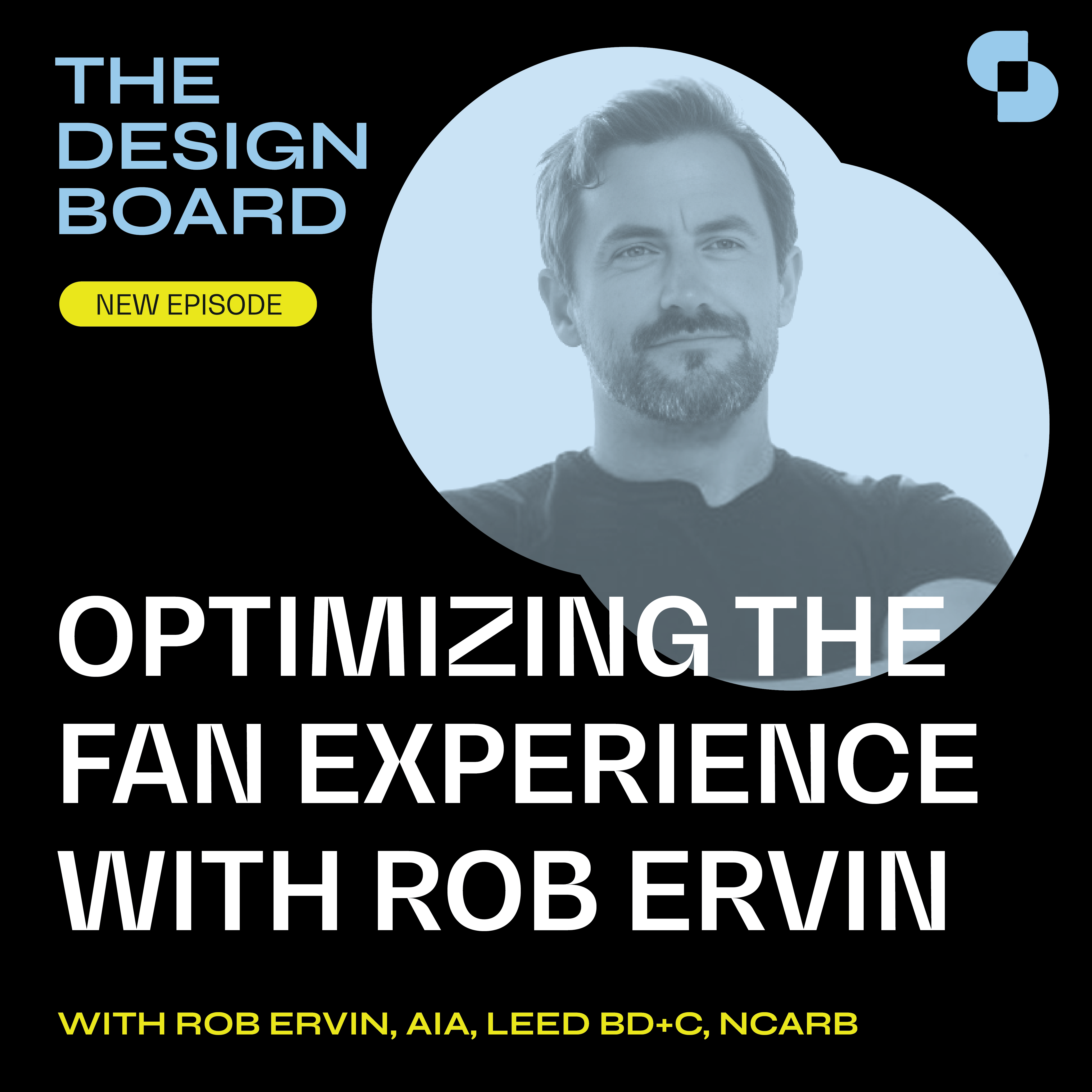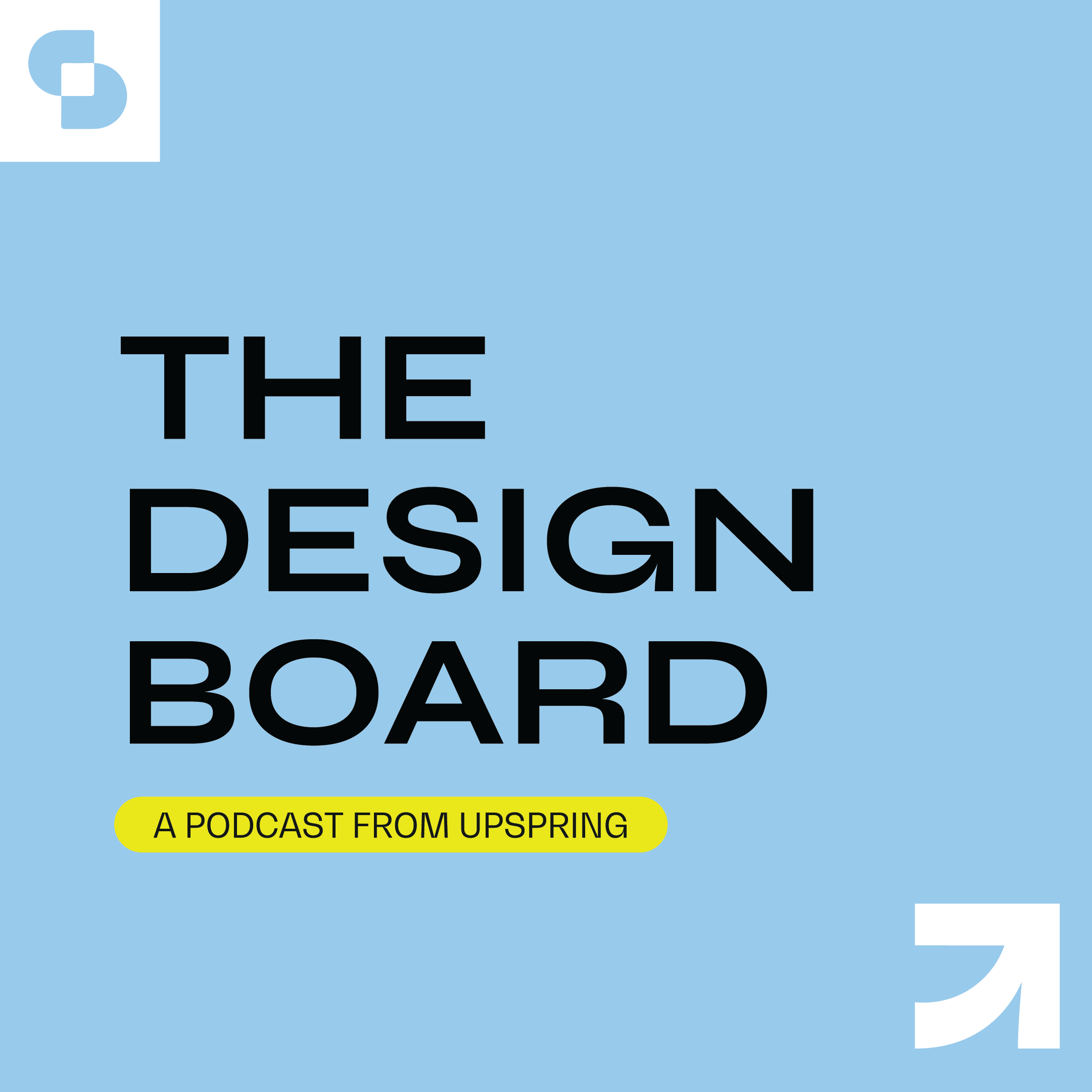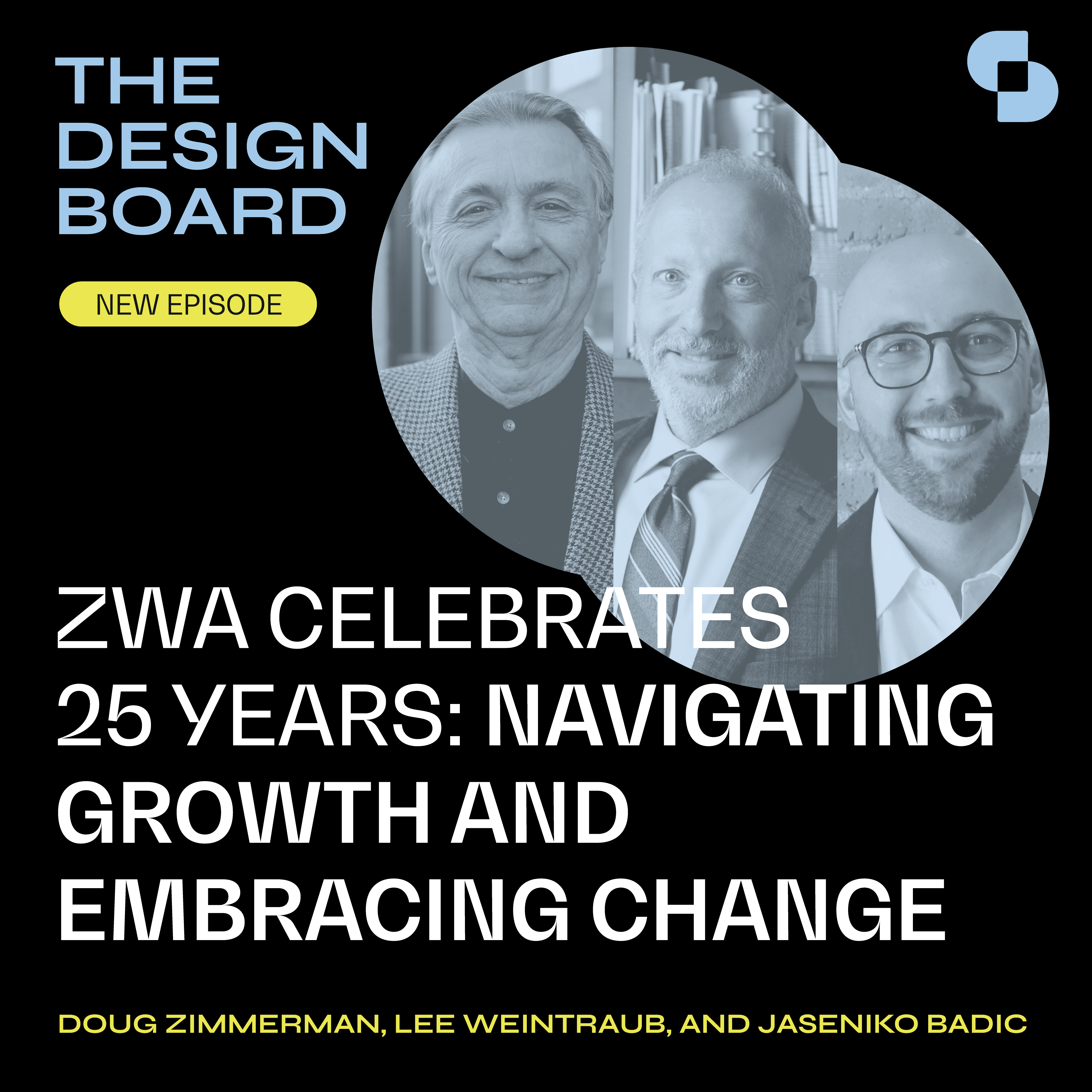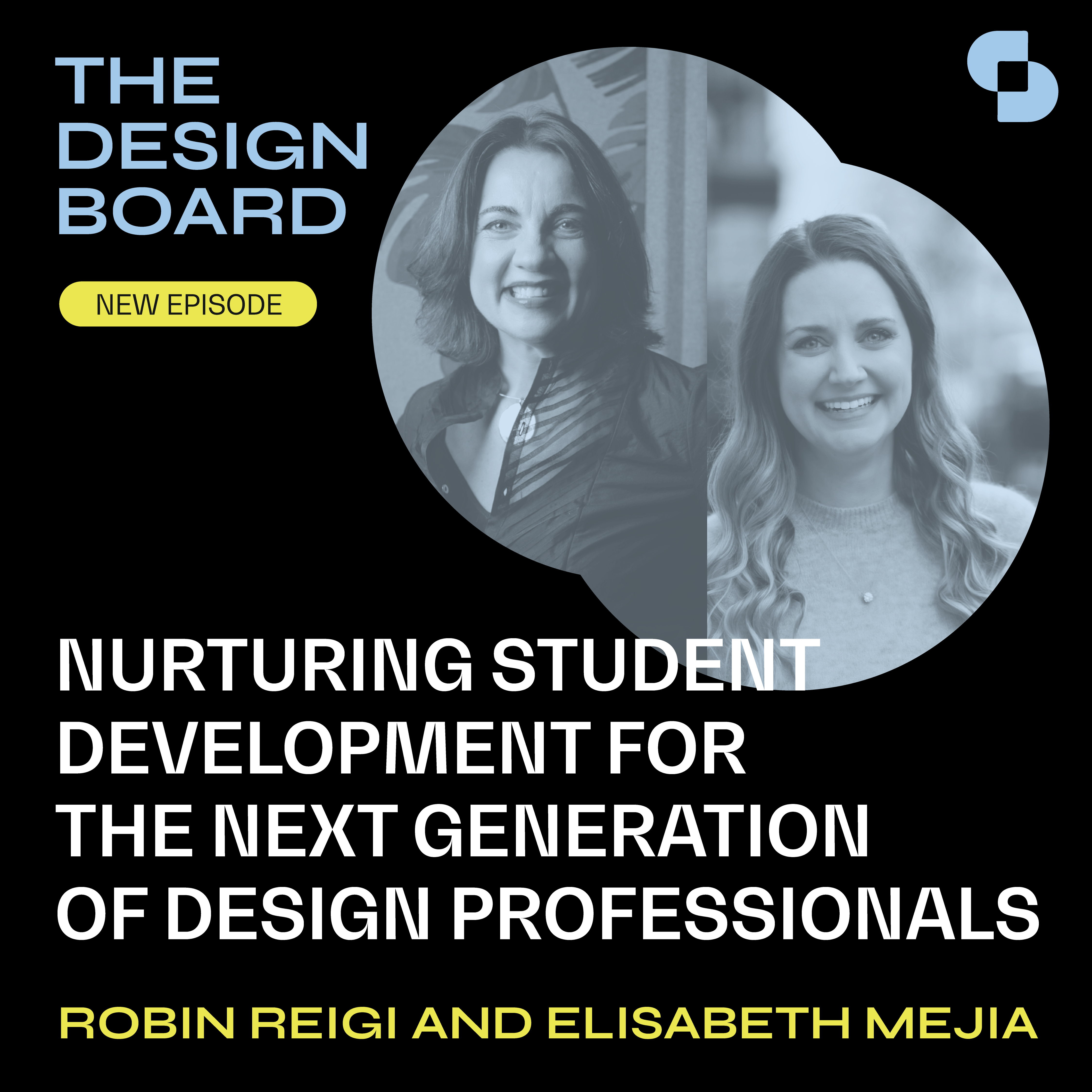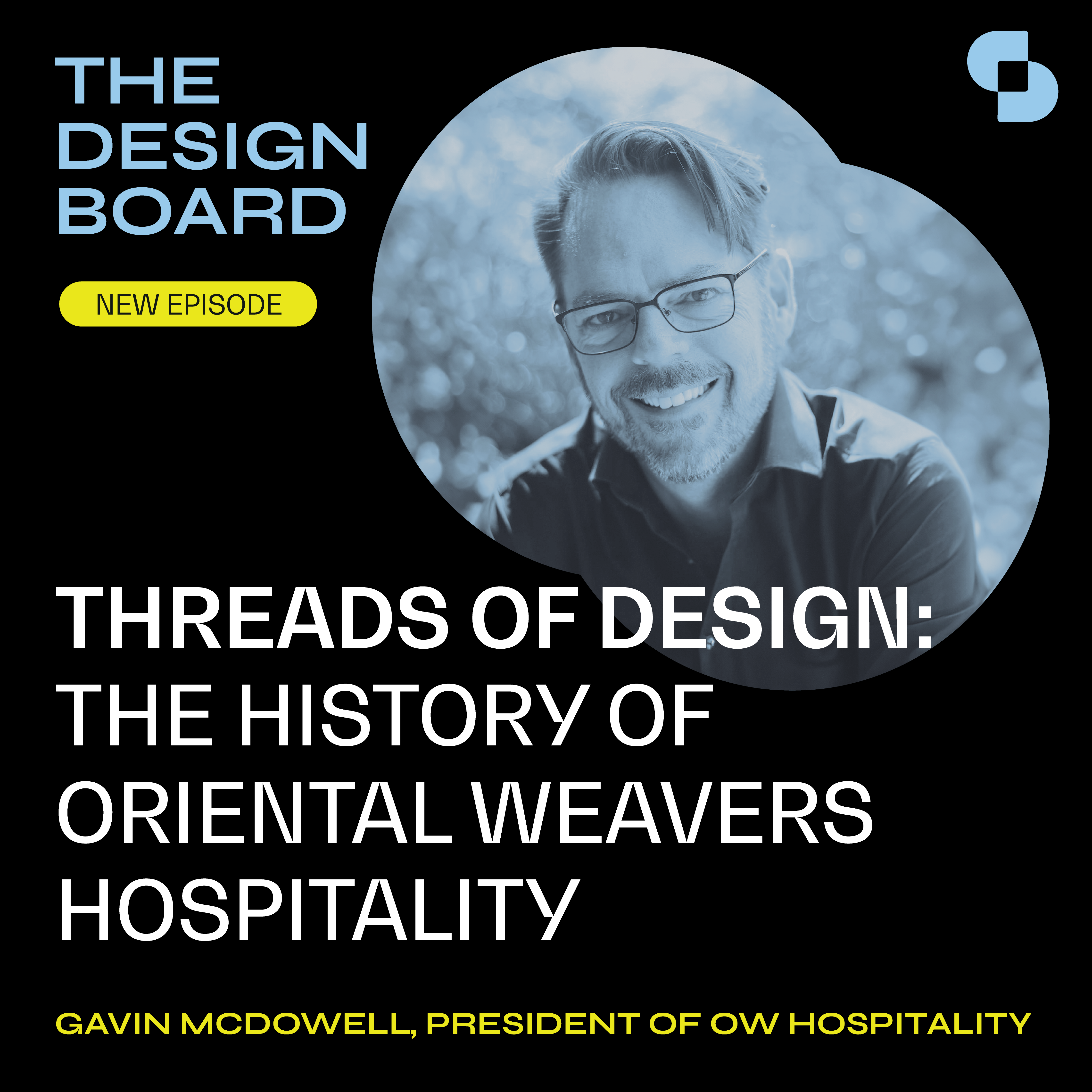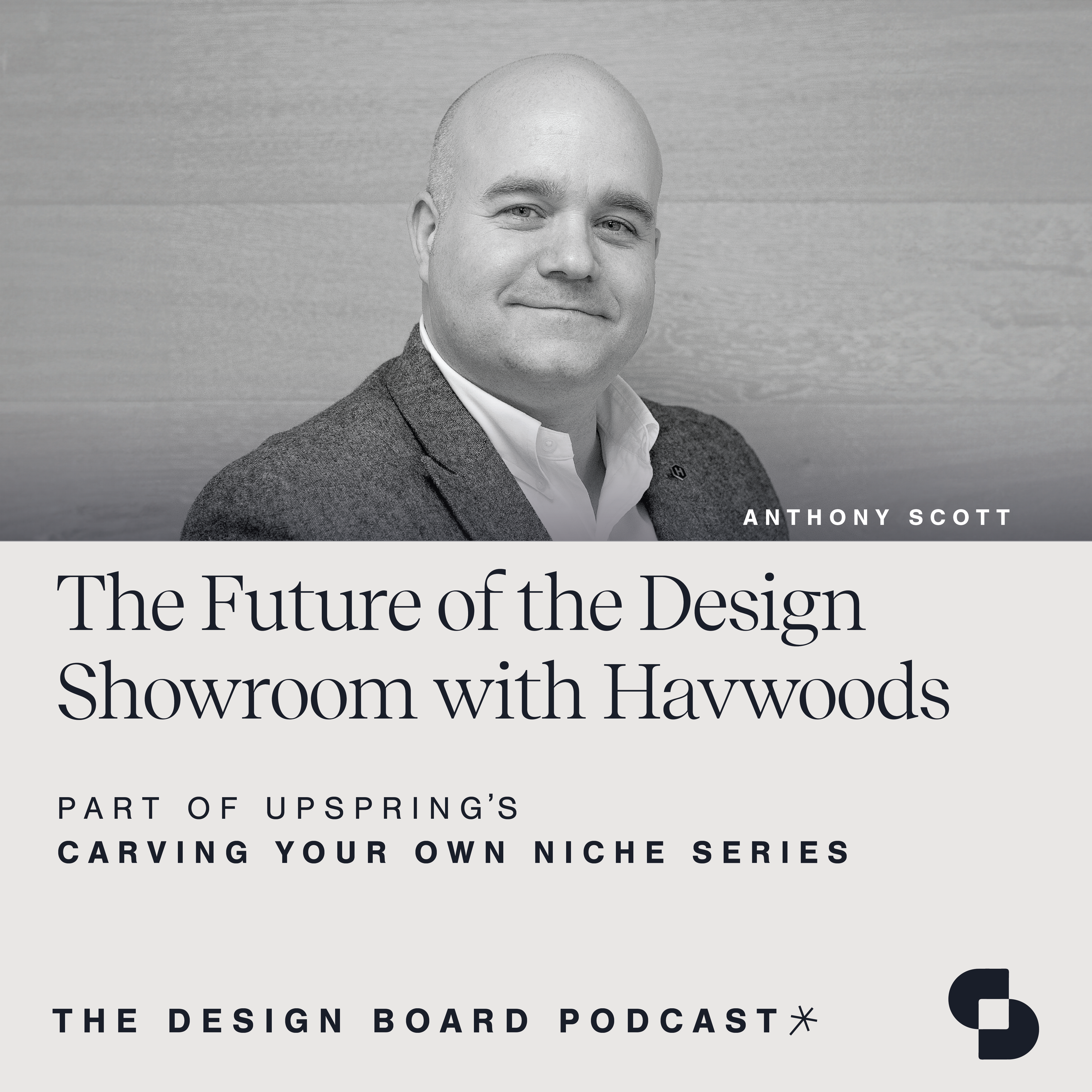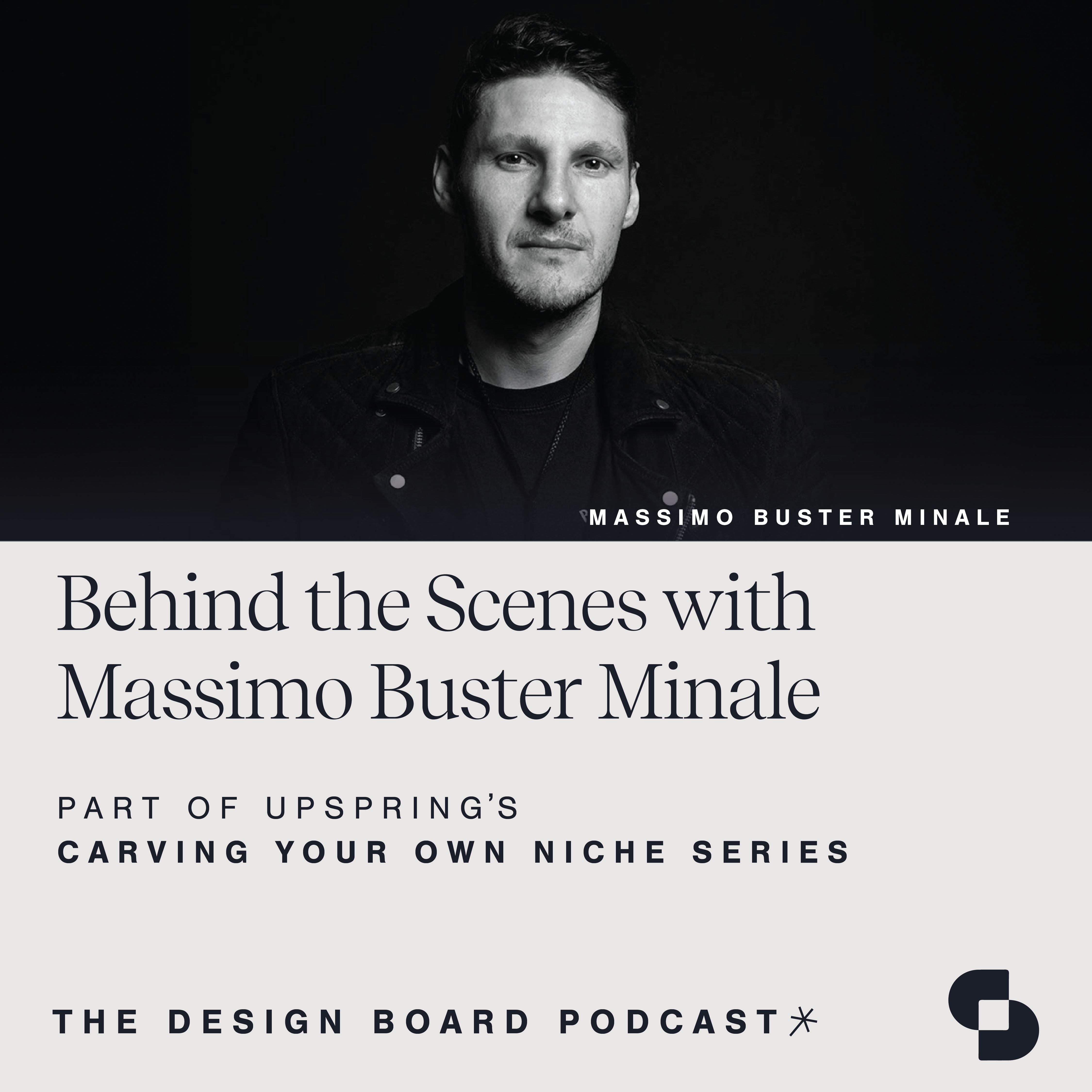Speaker 1:
Welcome to the Design Board, a podcast created by the team at UpSpring that focuses on design, development and everything in between. We invite innovators in our industry and explore topics that support your growth in every way. The Design Board is a proud member of Surround, a podcast network from Standout Design group featuring the architecture and design industry’s premier shows. Check it out at surroundpodcast.com.
Susan Fernandez:
Welcome everyone to the Design Board, a podcast by UpSpring that focuses on design, development and everything in between. We host innovators in our industry and explore topics that support your growth in every way. My name is Susan Fernandez. I am the Vice President of Digital Marketing at UpSpring. We are a PR and marketing agency dedicated to the design industry and built environment. Today, I am fortunate enough to be joined by Jacob Marks, founder and designer of Skram Furniture. Named one of the top 50 young designers of the Americas, Marks’ work has earned national and international recognition for its singular marriage of austerity, warmth, and timelessness, and an uncompromising technical mastery that is accentuated by the use of natural materials like wood, leather, stone, and metal. Trust me, go to the website, check it out. It is absolutely stunning work.
His approach is deeply rooted in the philosophy that argues for good design, extraordinary workmanship and sustainability, distinguished for his organic hand shaped seating and spare rectilinear case goods and tables unique in their negotiation of proportion, line and visual weight, Marks’ highly sought after designs have been showcased in a range of residential and commercial spaces throughout the world.
Jacob, welcome to the show. You are living the dream. So often it seems that being profitable and creative are mutually exclusive. You are a man on a mission with a strong brand ethos to design and build for a world that is not disposable. I love that. Can you start by telling us a bit about your background and what inspired you to start your own furniture design company?
Jacob Marks:
Yeah, sure. Well, I’m from the upper Midwest, I went to college in Colorado at a small school called Colorado College, and I studied history there. So I got into design after college. I don’t have any formal training. I think usually when somebody learns that I’m self-taught or whatever, they see my background in history and there aren’t any obvious connections, you know what I’m saying, between what I do and the study of history. But for me, there’s this really strong through line between the two. What drew it is the study of history, the craft specifically of writing history and design, the type of work that I actually do for a job. And that connection really is about writing history well is a craft that requires this really special blending of precision and creativity. And it turns out, I discovered later, that designing furniture in the way that I do it at least is the same exact thing.
You have this negotiation that every time you’re designing something, you’re trying to balance or keep intention, these accuracy concision in writing or origin in design against these, the more creative forces. So to me, in terms of my background, that through line has always been, I guess at least I realized that that’s been a very strong plan for me as I’m drawn to these vocations or applications that require that sort of merging of those two things, that seems to serve me fairly well.
So anyhow, how I got into starting Skram or whatever is graduated from college and was filling out doctoral program applications. Lived in San Francisco after I lived in Brazil for a little while. And while I did that, I discovered design, and from there very quickly shifted gears and sort of immediately sensed that everything that I loved about the craft providing history was there for me in the world of design. But then there was this added kind of benefit, which is the physicality of actually building things, physicality of this work. It is a big deal for me. I like to be active, I like to be dealing with raw materials, and it’s a really nice feature of the work that I do. So anyway, I got into San Francisco and then after maybe three or four years moved to North Carolina with the intention of opening up my own workshop. So I was about 25, so 23 years ago I moved here and started up.
Susan Fernandez:
Wow, that’s really impressive. I love this vision of coming from history. I think in everything you’re saying also, there is this, I would think that history requires also this objectivity to really see something for what it is. And I feel like that comes through in your materials. You really push the materials to be the most they can be. Their natural personality.
Jacob Marks:
Yeah. There is that. And then there’s also not fighting the materials, I suppose the other side of that, which is that you have to let, natural materials will always surprise you, and we only work in natural materials, so it’s kind of like you have to come to peace at some point with material that won’t do what you want it to do or whatever. And so there’s a certain kind of openness or maybe a beginner’s mind to crafting things in the way that we do.
Susan Fernandez:
So a beginner’s mind that’s very Buddhist, that’s sort of a very Buddhist approach of what is.
Jacob Marks:
Yeah, there’s a lot about this work, frankly, that there’s a fair amount of repetition on the floor in terms of being a disciplined designer and a disciplined furniture maker. There is sort of a piece that if you are good at it, that you come to terms with that repetition. And maybe that sounds Buddhist, I don’t know, but to me it’s very much a part of the discipline of what we do. And if we do it well, then there’s definitely a comfort with that joy in that.
Susan Fernandez:
That’s really beautiful. Can you tell me a little bit more? So I love this notion of really making peace with the material and then creating something almost that the material is speaking to. It’s playing an equal role in this creation. Your product design is very distinctive. When I was looking at it, there wasn’t one thing I could say like, oh, you always do this, you always do that. But I think if you put the collection together, you say, oh my gosh, this is absolutely Skram.
Jacob Marks:
Well there are things that I always do. I think, there’s a few things, and I know that’s not your point, but there are a few things that carry through in terms of the dorky side of talking about proportion and line and weight and stuff like that. There are some things that I cannot accept a certain approach to proportioning or conversely, I’m always going to have what I would call a certain heaviness at the floor. There will always be in good way, but a groundedness to the objects. So even though there may be a strong cantilever or a very light edge to something, there’s that tension between the object being kind of weighted on the ground and then this, I guess, juxtaposition against the lightness of the object. And that is something that I think that I could look at the work and be like, yeah, I can’t handle it if it looks top heavy, for example. So there’s always this at play, for example. I can’t remember the first part of what you said, but I kind of took it in a different direction maybe.
Susan Fernandez:
No, I think that was really good. I like the way that you describe it and it’s a very disciplined approach. So can you tell me a little bit more about the design philosophy and principles that guide your work?
Jacob Marks:
Well, I mean there’s a lot of ways I can go about answering that. And then I think that I love talking about design period. The things that we were just talking about. I love to talk about the things that I do in that way. But the goal, I guess in terms of a design philosophy is the idea of adding beauty to the world, like we talked about in the video, or I guess put a little more directly the idea of creating things that are enduringly beautiful, and those two words are where it’s at for me, because the enduring part is where it gets interesting. It’s one thing that it can be really pretty, but it’s sort of not so pretty anymore if it’s in a landfill. It’s another thing to design objects that both can and should last. And that’s what’s interesting to me. I don’t nail it every time or whatever, but that is the mission in designing these things that I don’t think I would want to do this work if it was for this ephemeral or throwaway output.
For me personally anyway that’s not where it’s at. So it’s in terms of a philosophy, it is that sort of inseparability of design, but thoughtful, well conceived design with a real devotion to things being very well made so that they can have that long shot at being the equivalent of the briefcase that you develop all of these attachments to that you just want to get fixed, that you would never dare throw go away. Or the pocket knife that I keep in my pocket, that’s not the best pocket knife in the world, that it’s not flashy, shiny, but it’s like it’s everything that I want. And I’ve developed this relationship with that pocket knife. And so these objects, these inanimate objects that surround us are the objects that I create. I’m not putting out fires or rescuing children, but adding beauty to the world in the way that I’m talking about it.
Well, I think that’s fairly important. I mean, I think that there’s something there that intrigues me and that I feel strongly about. And I think that that message that obviously where this is going in terms of my focus or whatever, part of this has to do with the idea of disposability and things having a lifespan that is intentionally short. Things that I don’t want to have any part of as a designer, but we can talk more about that later if you want to.
But it’s like all of the aspects of design itself in isolation are fascinating to me. But the ethos, the philosophy inside of it really has to do with reaching an audience that kind of shares that value that’s fed of set up with buying things and throwing them away, whether they’re our residential customers or the commercial folks that we do. We see this change in 23 years. I think I’ve seen things moving in our direction a bit, and it’s obviously a process and it’s not simple and quick cut, but it makes me happy to think that there are a lot of people out there that feel the same way.
Susan Fernandez:
Yeah, I would say that what you’re creating, they’re powerful pieces and they do have a certain energy about them that feel like something that you can see someone coveting and passing down. I always think about that. I have a friend who was fortunate enough to inherit a lot of incredible furniture from her European family, and I mean, they’re just really beautiful. I think you’re bringing up something that’s really important that I wonder what kind of shift you’ve seen in the 23 years of designers now looking for the type of work you’re doing, because it seems like they’re always trying to balance price and beauty and function.
Jacob Marks:
As well they should. And so I can’t say that the work that we do is for everybody on every project, and that’s not the intention. The idea of where the right scale is for a company like ours is, it’s at the center of things for us. But in terms of our audience, I think that for me, it’s just become a more elevated conversation about the value proposition that a brand like ours represents, meaning what we deliver relative to the cost is from what I understand, in terms of outside feedback quite a lot.
And it’s been a very sort of passive approach, I suppose, to very organic building of this business over the years. It’s sort of receiving orders versus seeking orders or whatever, and that’s not quite so simple, but that allows us to see the growth that we have had happen. It’s kind of to gauge whether the experiences that people have interacting with a brand like ours versus a brand with a whole different set of priorities to see how that’s received. And then further to that, the word of mouth kind of aspect of our growth indicates to us, and it’s sort of in a way that we believe in that what we’re communicating and then what we’re delivering, that that’s a nice proposition for people that they continue to seek out as return customers or that they spread the word for us and become our hemispheric.
Susan Fernandez:
Yeah, we’re certainly seeing that in all aspects of the design community, this real move towards sustainability to moving out of landfills and to be able to explain that to clients and having clients value it.
Jacob Marks:
It’s a long game. That conversation is a long game for us. We can’t have it in every interaction, but there are ways that, for me, the work itself affirms the message that we’re kind of trying to communicate. And so in lieu of my voice saying to somebody, “This makes more sense”, or, “Aren’t you really sick of throwing away your entire office every five years?” Or, “This is the dining table that table will fuel great memories for the rest of your life.” Instead of having to say those things, they can experience those things themselves if they’re sort of open to it. And then, like I said, from a value proposition standpoint, it’s not what somebody might be imagining. It’s not a singularly luxury product line.
We very intentionally keep levels of products available for what we hope is this somewhat wide range of potential customers so that somebody who loves design but isn’t rich can experience what we offer. And as they progress in their life, they might call us back in few years or whatever, but it’s really not, like I said, we can’t compete with a Steelcase desk made out of plastic laminate, nor do we want to, and we do want to counter those impulses towards disposability. But it’s like we’re a relatively small company and there’s a lot that we can do, and there are things that we can’t influence other than to have the conversation.
Susan Fernandez:
So really aligning with the right designers who find you, they select to you has put you into some notable projects. Can you talk about something recent that was a good project for you?
Jacob Marks:
Yeah, I mean, we’ve been doing, I mean, there’s always these gorgeous residential projects where we have these designers that we work with just constantly that there’s a lot of really wonderful projects that I can think of in the mountain west where our work seems to fit in very well. And then I can think of a beautiful residential project in Houston. Some of that work is actually right on the homepage of our website, and I just loved how that project came out and how well it was curated. But yeah, I mean, the residential stuff happens all over. It’s not always easy for us to get photography of it in these private residences, but on the contractor commercial side, that’s where we’ve done more kind of high profile stuff, I suppose, or things that would name recognition, the C-level suites at Nike World headquarters, that was a beautiful project.
And then otherwise, I think the ones that I’m drawn to have to do looks like when we’re able to do nice chair projects, and for me, chairs are the thing. It’s what I would do if I was able to, only do chairs. But the chairs that we build are, they’re way more well traveled than I am. They’re at beautiful resorts [inaudible 00:19:38], things like that. But I don’t know, in terms of the project, establishing credibility, all of that stuff is important, and that’s all there for me. It’s kind of like, I love that, okay, fine, Nike World headquarters or the MGM Grand Hotel, that was just whatever. I love that. But more than that, I love that every five years we get a phone call from an end user in Peoria, Illinois who’s just what I was talking about earlier, who’s been saving, knows exactly what he wants, not a wealthy person, but is a connoisseur of design. And he calls, he orders his desk or his console or whatever and just goes around the office.
And everybody’s just so pleased to be able to serve a client like that just as much as we are pleased to be able to do a more high profile project. So I think that’s an important thing for me anyway, to be able to do that sort of work and the key products in the line that are somewhat of a broad range of consumers.
Susan Fernandez:
Can you walk us through how you approach a new design? What factors do you consider when you are creating a new piece for the Skram line?
Jacob Marks:
Yeah, I mean, it almost always still starts at least with a blank page and pencil, but depending on what I’m doing, I mean, most of the time the products that we released have been simmering in my sketchbook, in my thoughts while I’m driving. A lot of design, simmering happens while I of sleep. But basically at a certain point, what I’m really talking about, I guess with that preface would be the more sculptural, the more artistic stuff. A lot of the seating pieces that I do just for the pure joy of design in the pure sense, the other side of things I’m equally passionate about, but they’re more technical in a different kind of way. So for example, right now we’re in the kind of final push on this really involved shelving system that’s this really amazing mix of metal and timber open storage and closed storage.
And it’s meant to be this totally configurable, it could be as big as your wall, as tall as your ceiling, or it could be scaled down to the tiny little console, but it has these sort of universality of design language, some componentization lighting integrated and connectivity. So there’s all of this very technical kind of layering of stuff. And so for me, yeah, there were sketches in the sketchbook, but I pretty quickly, as somebody who can’t draw that well by hand, I’ve always kind of done those sort of thumbnail sketches and then pretty quickly move to my computer where I use a Dream modeling program and can kind of begin to put the pieces together from there.
Again, depending on what it is, there’ll be like with the new seating design, the V4 chair that we just launched last year, that is a fairly involved drawing process. And then we actually do some visualizations before it goes onto the floor and then the prototyping starts. And that process, that’s my favorite. That’s where I’m a little kid again, just get to be reminded of what I love. It’s still the same that it’s always been when I was starting out, meaning that excitement as you get close and you want to see it come to fruition and all the little technical challenges the way that you have, it’s a nice reminder now and again, why do what you do.
Susan Fernandez:
So when you think of your line, do you think we need to create this because we’re getting feedback that we need a shelving system, or does this all just come from you having a vision and seeing, oh, the next piece should be this?
Jacob Marks:
Well, I’ll tell you. So the shelving system actually, we have an existing product called the Altai Shelving Unit. It’s from the Altai Collection. In this case, the client is a large global car company. They saw the unit in our New York showroom, and they approached us to develop this system for pilot projects and then for potential broad rollout. So that’s us taking an existing product and completely transforming it, but keeping some of the language that was used that was attractive to the client in the first place. So yeah, this one’s a little bit different.
In terms of developing new products. Usually that happens under more normal circumstances or for the residential side of things, but very often we’ll find a hole in the line where we have a very natural kind of opportunity to do a new design and then using the language of let’s say the Piedmont Collection or Altai side, if we find that we’re customizing a certain piece to accommodate a certain function quite often, sometimes that leads to the development basically from scratch. But using some of the information that we’ve gotten from the interactions we’ve had with our clientele, for the most part, the feeding is just out of my head. That’s not based on feedback subjects, customization or anything like that. It just is what it is.
Susan Fernandez:
It just comes to you.
Jacob Marks:
Yeah, something like that.
Susan Fernandez:
So shifting gears, I’m curious about the challenges you faced when you started Skram furniture. It’s a really big undertaking to become an entrepreneur. Can you tell me about any of the obstacles you encountered and how you overcame them?
Jacob Marks:
Yeah. Well, probably if I knew that entrepreneurship was part of the deal, I might not really not have done it, but since then, I’ve become an accepted part of things. Yeah, I mean, I don’t know. I think that there’s, for me personally, in terms of my path very early on, one of the biggest obstacles really had to deal with myself and the fact that I don’t have any formal education. I was sort of one, I never really had this moment where I was just playing around where I was playing and learning and exploring without any sort of idea that I would need to feed myself or whatever. That was always part of the deal. And so there was some time early on where I had some insecurity I think, about that background and worried that I was in over my head or whatever.
And in terms of solving that sort of things, I don’t think it’s entirely solve yet. But I think that the idea is that there’s a level of peace and confidence in terms of what I do well, and then at this point, there’s this just unbelievable team of human beings that I get to work with every day that make this happen.
But yeah, I mean the early stage obstacles, other than that kind of more psychotherapy, one, the other ones would have to do with the fact that there’s not really a book that I’m aware of that tells you how to price your furniture for the AB market or how to price it for retail. You have to figure this stuff out on every level, every little thing. How do I ship this thing to LA? All, every little bit and piece has to be solved from scratch. If you’re doing this alone and you don’t have, and nobody around you is really trying to do the same thing which was just kind of the case with my experience. But the way you get through it is doing it, making a lot of mistakes, I suppose.
Susan Fernandez:
That resilience of being an entrepreneur to just keep going, that one step after the next, and I feel like you either have it or you don’t, and it is a game of the mind. It’s really kind of you against you or you with you, however you want to look at that. So what can we expect from your company in terms of innovation, new design or expansion into new markets? Do you have your eye on anything in those categories?
Jacob Marks:
Yeah, I mean, the one thing, and I guess I mentioned it earlier, that we’re all kind of almost for the first time ever, that we’re pushing more firmly on has to do with this idea of telling our story. So marketing, which if we just feel that there’s an audience that we want to reach and we want to reach on our terms in our way, in a way that we’re comfortable with and way that’s kind of true to our quiet approach to existing in the world. And so that video that went up on the website that we did with our friend Ted from Dubai, that’s an example of what we’re trying to do in that sense was just to communicate that message that we talked about earlier about who we are and let people in to the inside of our organization a little bit more to see what it means that in terms of these objects that we create actually for real being built by human beings, highly skilled human beings.
And so that’s one side of it. In terms of what we’re looking for and what’s on the horizon. For us, the big part of it has to do with we have a real interest and a real need that we’ve observed in terms of the contract side. And so we’re looking at this phased but formal, kind of, we do a lot of contract work as it is, but it all comes to us organically. And so because of that, we have this sense of where the unmet needs are, where and why people come to us and what aspects of that we want to nurture and what aspects we don’t. But that’s led us into this sort of process that we’re in the middle of right now, of where we want to exist in the contract realm, where we fit best, and where we can serve an audience that, again, sort of shares our values and is seeking what we offer.
And so we do a lot of these really gorgeous, large meeting tables, each boardroom tables and things like that, and those are really fun to do, and they’re a good workload for our company. From what we can tell, we provide something that really doesn’t exist in terms of the level of workmanship and permanence in that market. And so that’s one example of where we fit in, I think, in that world. But what we’re working on behind the scenes is actually trying to discuss what the right kind of slow, gradual smart way for us to, with more assertiveness, kind of exists in that space.
Susan Fernandez:
I think this is one thing that I see a lot, and I know there’s a certain type of artist, whether it’s an architect, a furniture designer, anyone that feels like marketing is along with a very low level of, it’s kind of something that they feel like the work speaks for itself. So this is what I do. The work speaks for itself. And I always think that there’s so many designers, there’s so many people that want to know your story because certainly that story is something that is meaningful to them and they want to align with it, and they’re looking for you. And then when they can’t find you is when they’re settling for other things that are probably stuff they are going to throw away.
Jacob Marks:
What we say to each other or what we communicate to other people is that for us, marketing really is a matter of letting people know that we exist. If we can let people know that we exist, then the job is more or less done. If we can tell them who we are and what we believe, that’s the end of the pitch, meaning there’s no further anything to be done. And if it resonates, then everything leading to their first experience with our customer service, our project management, our technicians, every aspect of dealing with us until they receive their first order is affirming of who we are. And then the product, once it arrives, that’s kind of a mission accomplished thing because in our experience that’s that’s a happy customer. So yeah.
Susan Fernandez:
Yes, that awareness component really is, and I do think that there are probably 1000 people that go to your website, and I feel like what your brand is so developed, it’s more of a gut reaction than a, you’re not going to sit on with a spreadsheet and be like, oh, we just can’t get those chairs. You’re getting those chairs. Now it’s about what else are we going to do? But I think people self-select there. They either get you or don’t.
Your design philosophy emphasizes the marriage of austerity, warmth, and timelessness. Can you elaborate on how you achieve this balance in your furniture designs and why is it so important to you?
Jacob Marks:
Yeah, yeah. I mean I think that on the design side, those three words, I mean, some of it has to do with what we talked about earlier in the conversation, but it has to do with this with other words, which is distillation or a question maybe what is essential. And that question of what is essential leads to, I think in part is responsible for those qualities to the extent that they exist in the work. I don’t need every aspect of every design to be the loudest voice in the room. I like for our work to reveal itself over time. Maybe there’s little surprises that happen, meaning you discover something or some aspect that you didn’t realize 10 years in, you’ll say, “Oh, well I never saw it like this.” Or, “Look how it’s changed in the sun and isn’t that beautiful too.” But this question of what is essential, I guess with the coming back that I mean isn’t what is essential to make a table stand up.
That’s not really what I’m talking about. Yeah, okay. Four legs or whatever. I guess part of it, and there is this idea of less is more unless there’s a good reason. But the idea of what is essential could be what is visually essential. Do I need to have this gorgeous little carved wooden sculpture on the bottom of the legs of this table? Well, yeah, that’s essential. In that case, it’s essential. So I think that at least asking the question what is essential and then trying to come at the design side of things with a little bit of humility or restraint, always checking your impulse to add or for more.
For us, it’s like there’s nothing to hide. There’s nowhere to hide in the work. It’s sort of fairly unforgiving from an execution standpoint, meaning there are no, for the most part, inlays or patches, it doesn’t fit with the aesthetic, the relationships, the reveals, the sight lines between where the wood and the metal meet. All of that is, it’s wrong if it’s an eighth inch and it’s wrong. If it’s a 16th with an inch, it should be 3/32″, period. And those sorts of details are, that’s what we’re after. That’s where it is for us, is for somebody to see the magic of human creativity when it’s right or technical mastery when it’s right. I guess that’s sort of what I mean by the little surprises in part is all of these kind of things that on the surface of the composition. You see an object, but then you look more closely and you look more closely and hopefully you see things that are also very pleasing that you might not have noticed in the beginning.
Susan Fernandez:
It’s beautiful. You’re very poetic. I like that.
Jacob Marks:
Thanks.
Susan Fernandez:
Your pieces are so well crafted. How do you ensure uncompromising technical mastery and attention to detail in the production? Are you collaborating with skilled artisans? How do you do this?
Jacob Marks:
Well, there’s very little outsourcing at all. And to the extent, I mean, everything that we build is built within 40 miles of here in North Carolina. So there’s a pretty tight level of control, and that’s essential to what we do. We do have good partners in a couple of different areas for a few different specialties, kind of partner brands that do the level that we do. Most of what we do here in our main factory is wood, woodworking. We have a metal shop here that’s properly outfitted, but it’s nothing in terms of the scale of what the wood size of the operation is. So we do have some great partners that we work with, but everything comes back here for final assemblies. Some things can go out, then come back. But for the most part is 90% of everything is built 100% here.
And then there’s odds and ends that go out and then come back. In terms of the bigger answer, the way that this works is you have this kind of tight rope that you’re walking. On one side, you have a factory sort of situation. On the other side, you have an artisan or furniture maker, whatever, and there’s this kind of a little bit of push and pull every day to try to keep things in balance. You want to maintain the character that that’s what makes connections with people, you want to bring out the life or the natural materials. And there’s no machine that can do that. There’s no factory that can do what we do in terms of deciding that this piece of walnut needs to go next to this piece of walnut, but not over there. All those little decisions, those can only be made by humans and in our world, they’ll only ever be able to made by be made by humans.
But then there’s the other side, which is automation, which is how we get scale, which is how we aren’t still working out of a little workshop in the forest after all this time. So the automation side of things is, the idea is that you have this symbiotic relationship that they’re not mutually exclusive, that my business, this business will never be automated out of its humanness. There is no way forward without that kind of artisan factory, factory artisan kind of balance. That’s what makes it work. If a 17th century furniture maker time traveled and walked into our factory, it’d be different. There’d be a lot that would be like, “Wow, this is different. What does that machine, what does it do?” And whatnot. But then that person probably look around a little bit more and realize, okay, that’s just saw and feel pretty at home.
And then when they got the automated part of things, they would realize that one, there’s a level of repeatability and precision and speed that no human could even begin to consider touching. Like it’s astounding and phenomenal. But more than that, the furniture makers, the journeymen lifetime professional furniture makers that work here, have no issue at all with the automation, because what it does is it frees them up to do all the things that I was just talking about, which is the craft, not the repetition, not to cut the same joint 500 times, but to be able to make all those little decisions that give this stuff character.
Susan Fernandez:
And you’re in an area that is that journeyman area of craftsmen for furniture in the country. Is that still a thing?
Jacob Marks:
Yeah, High Point or yeah, central North Carolina is very much one of the major hubs still to this day of domestic furniture manufacturing. We haven’t had a lot of success hiring. That’s typically more on the factory side of that artisan factory tightrope. So in general, the journeyman level of furniture makers that we have have actually not come from the High Point area. It’s wonderful to be here, and it’s a good place to run this business. We have amazing access to resources and suppliers. It is quite a good fit. It’s also really nice to be here trying to operate slightly on the outside and slightly on the inside of what’s going on, and to see and to get a better understanding for what a model of domestic manufacturing that’s sustainable could look like to try to present that and to be it, to model behavior in a corporate way that at least promotes the idea that it’s possible to do this work responsibly.
Susan Fernandez:
I think in line with responsibility is sustainability, which is a fundamental principle at Skram. So how do you incorporate sustainable practices into your designs and the manufacturing process?
Jacob Marks:
Yeah, I’m happy to talk about the subject. I guess you could break it down into two. There’s two levels of this. One of them is kind of a checklist almost. And you see all organizations now kind of do some sort of checklist. We do this, we do this, we offer this. And so on in our case, we have the meaningful, I don’t mean to be diminishing of that, that’s important. And if it’s honest, then it’s meaningful. There has to be some sort of accountability and more than words spoken, there has to be kind of actionable, demonstrable kind of indications of what it is that we’re doing as companies to be stewards of the environment or not be stewards of the environment. So in our case, we have the biggest thing for us has to do with our solar installation on a roof. And we’re hoping in the next few years to be able to double that.
So basically half of the power that it’s Graham consumes in the construction of our product comes from the sun. And for us, that was a big deal. It was a huge cost or whatever on this old building, but that was the single, I think when we discussed how we could put into practice in that sort of checklist kind of way, what was the single biggest thing we could do that one won out far beyond any of the other comparable comparably costs.
And then in terms of other things, we talk about regional sourcing of our materials. So we try not to ship exotic timber from all over the world. Most of our timbers that we use and that we love are the finest Appalachian hardwoods available. And they’re all within 300 miles or so of our factory. Our mill is 80 miles west of fear. So that sort of thing.
And then in terms of just the toxicity and mitigation of the use, in our case, non-toxic pieces, Greenguard certified finishes on our products, all of those things are super meaningful. And to us, that’s a process. So we have to kind of overtime meter our development in that regard and try to, with honesty, kind of say where we are and where we want to be. And we’re not exactly where we want to be, but our efforts are ongoing, sincere and legitimate. The main thing and the main area of focus is not that, though. I would say that the main point to drive home for us is it does come back to that idea of disposability. We don’t intend for our products to be thrown away in a few years. If your products are disposable by definition, you really better think about what happens when you throw that thing in the landfill.
For us, I mean, it’s completely at the heart of who we are or what we are as an organization, but it’s like the idea that if we can keep these items out of the landfill, that far above any checklist item, that’s the thing. That’s the thing that wings out a hundred-year lifespan versus a two-year lifespan. There is no competition in terms of, well, it might be better if we built this thing out of bamboo or whatever. It’s not even in the same league. And so the focus really it is that, both because it’s at the heart of, I guess, what I believe as a furniture maker, we talked about in terms of a design philosophy, but it’s also in terms of being a steward of our world, whatnot.
Susan Fernandez:
And the product endures. And that really is truly the crux of the sustainability. Designers are notorious for customization. They want to see what you have, and then how much can they change it. And your designs have a very strong integrity. So do you allow for customizations, and if so, how do you strike that balance between keeping the beauty and the integrity of your designs and yet allowing designers to have a say in how they finally are produced?
Jacob Marks:
For the most part, it works out great. Yes, we do customization. And for the most part, it’s great. Usually people come to us with a sense of what’s appropriate to ask, and then a reasonable deference in terms of the fact that the products are not engineered, designed, engineered on a whim, that there’s thought behind every aspect of them. If somebody asks for something that will make it ugly, we’ll say no. And if somebody asks for something that’ll make it structurally compromised, we’ll say, no. My preference is for people to give us some room to maneuver, meaning, “I love this table. It’s too big or whatever. My space is like this. My space is this size. Can you help me make it the right size for the space to accommodate this many people if possible?”, so on and so forth. And not, “It needs to be like this.”
And then the idea of it’s really more the exception than the rule, but the idea of people making the mistake of thinking of our organization as a job shop for what they want to build, that isn’t quite the right fit for us. It’s not like a custom cabinet shop exactly, but totally open to customization. It’s a tremendous part of what we do, and it’s not just by means of accommodation. There’s a lot of great that comes out of that collaboration and the communication, the reciprocity, what we get in terms of something new, moving through the floor that’s a little bit different, an iteration that we’ve never seen before, or a materiality that we’ve never seen before, a configuration that we’ve never seen before. It kind of keeps things interesting.
And I know, I mean, I enjoy the right kinds of custom projects, and it’s not, so there’s the one-off kind of bespoke ones that have their own challenges, mostly residential, but sometimes there’ll be a contract bespoke really special piece in the lobby or whatever. So there’s that side of things. And then there’s the custom contract stuff, which is a completely different story, but that’s also of interest. It just has to be the right fit. And the right fit starts with somebody already kind of loving the aesthetic and then just saying, “I just don’t see this in your line. Can we work together on this? I think it would be amazing.” And then we’ll be like, “Yeah, that sounds great. Let’s build that.”
Susan Fernandez:
And finally, any advice you would have to young Jacob, to anyone who’s just starting out in furniture design and they’re thinking, “I want to start my own company.”
Jacob Marks:
Let me know when you figure it out. I don’t know. No, I mean, I don’t know what to say. I mean, the persistence be prolific. Keep going.
Susan Fernandez:
Very good. Thank you so much. Is there anything I didn’t ask you that you would like people to know?
Jacob Marks:
No, you nailed it.
Susan Fernandez:
I love the way that you describe it is this like art. It’s this tension there’s a constant tension in everything you do of how far can you push the material? When does the material start dictating how much is made by a machine? Where does the artisan come in? It’s always this, and just looking at your designs, there’s a tension between the negative space and the line. It’s really fascinating. Thank you so much.
Jacob Marks:
Oh, it was a pleasure. Thank you. Really appreciate it.
Speaker 1:
Thank you so much for listening in with us today. We hope you leave inspired by the ideas in today’s episode. For more follow UpSpring on LinkedIn and Instagram. And don’t forget to check out the amazing lineup of shows brought to you by the Surround Podcast Network at surroundpodcast.com.

